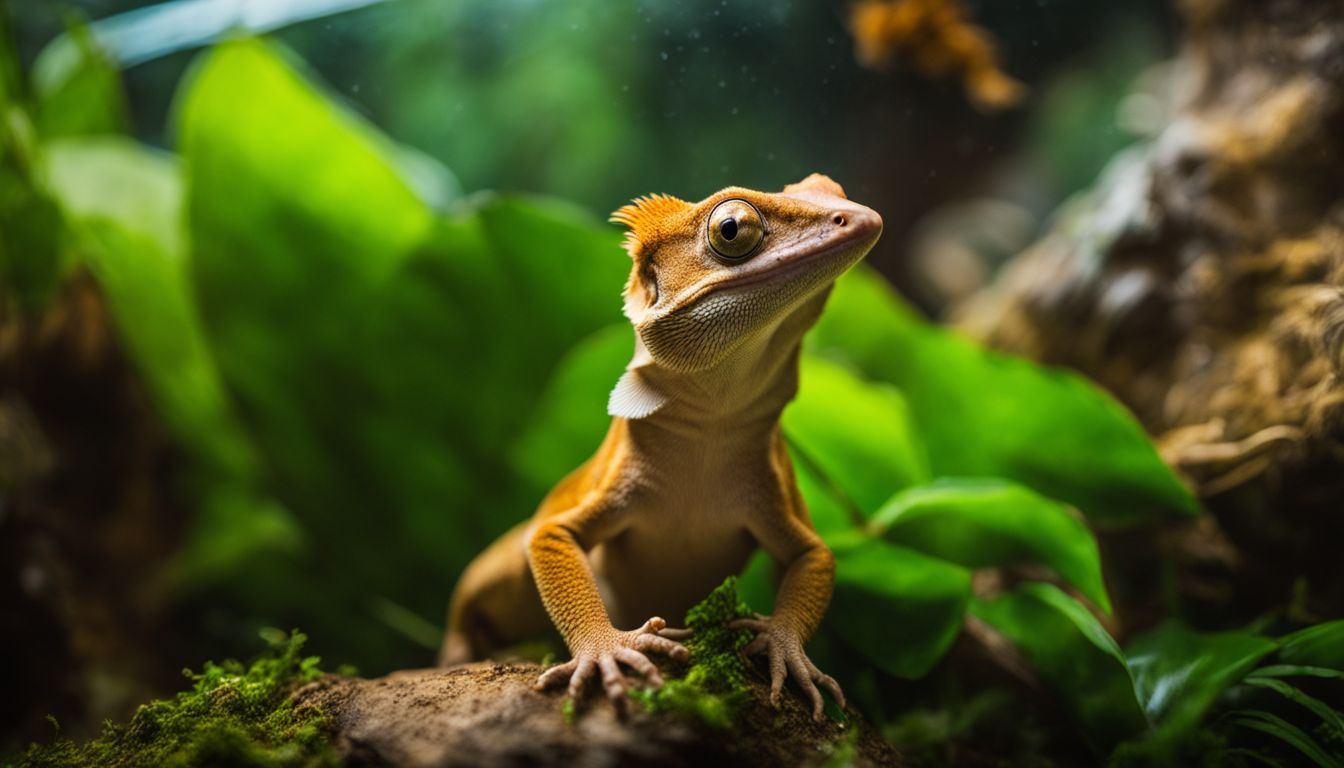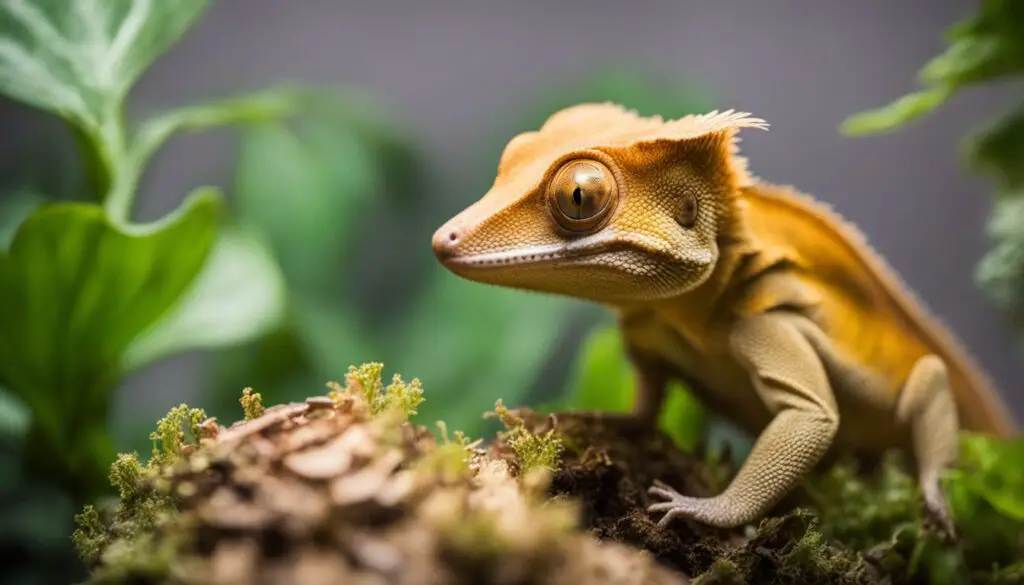Have you ever noticed your crested gecko looking unusually pale and wondered why? As a loving pet owner, it’s natural to worry when you see changes in your little friend. Pale coloration can be baffling, but often there’s a simple explanation: shedding, mood shifts, or tweaks in their living space could be the culprits.
One important thing to remember is that crested geckos are known for changing hues as part of their normal behavior – they “fire up” with bright colors or “fire down” with paler shades depending on various factors.
Our article will guide you through understanding these color changes and how to ensure your scaly buddy stays healthy and vibrant. Dive into the colorful world of crested geckos with us; let’s figure out this puzzle together!
Key Takeaways
- Crested geckos change color as part of their behavior. Shedding, mood shifts, and environmental factors can cause pale coloration.
- Pale color might indicate shedding or mood changes in the gecko. Ensuring proper lighting, heat levels, humidity control, safe habitat setup and regular cleanliness is crucial for their wellness.
- Age – related color shifts are normal. Watch out for signs of illness beyond pale coloration like loss of appetite and lethargy.
- Providing a balanced diet with essential nutrients such as calcium and vitamin D3 is crucial for maintaining vibrant coloration and overall well-being.
Normal Color Range for a Healthy Crested Gecko

Crested geckos come in many shades, and their healthy color range is quite wide. These little reptiles might show off colors from bright yellows and reds to deep browns and soft creams.
A crested gecko’s skin may also have patterns like spots or stripes that add to their unique look. Their colors can get darker or lighter depending on the time of day – this is called “firing up” when they become brighter, and “firing down” when they are less vivid.
The normal color for a crested gecko can shift with mood changes too. When relaxed, they might show lighter colors, but if scared or stressed, darker hues may appear. This change in color helps them blend into their environment which keeps them safe from danger.
Healthy crested geckos should be able to switch between these colors easily as long as they live in a good home that has everything they need – like proper food, light, and warmth.
Unraveling the Mystery of Pale Coloration in Crested Geckos

Understanding why your crested gecko may appear pale involves considering factors such as shedding, mood changes, and the environment they live in. These elements play a role in their coloration and can help you better care for your pet.
Shedding: A Natural Cause for Paleness
Your crested gecko might look pale, and often it’s because they are getting ready to shed their skin. Like many reptiles, crested geckos shed their old skin to grow. Before they start shedding, you’ll notice that their colors seem duller and greyer.
This is a normal part of their life and shows your pet is growing.
Crested gecko shedding can happen often, especially in young ones who are still growing fast. A good sign your gecko will soon shed is its pale look. Keep the humidity right in their home by misting and watch for them to begin peeling off the old layer of skin.
Once they have finished shedding, their colors should return to being bright and beautiful!
Mood Changes: The Emotional Palette of Your Gecko
Shedding might make your crested gecko look different for a little while, but their moods can also change their colors. These cool reptiles can “fire up” and “fire down,” which means their color gets brighter or darker depending on how they feel.
If your gecko is chilled out, it might have soft colors. When excited or warm, it may get more colorful.
Stress can make a crested gecko go pale too. They don’t like big changes or being scared. Keeping them happy with the right light and heat helps their colors stay bright. If you see your pet looking pale often, check if something in its home could be better.
Maybe the light’s too bright or the place feels too cold for your little buddy to relax.
Environmental Factors: Light, Heat, and Habitat
Healthy environmental factors are crucial for maintaining the color and well-being of your crested gecko. Here’s what you need to know:
- Proper Lighting: Provide a consistent light cycle mimicking their natural habitat, using UVB lighting to support their calcium absorption and overall health.
- Optimal Heat Levels: Maintain temperatures between 72-80°F during the day and slightly cooler at night, ensuring they have access to warmth without overheating.
- Humidity Control: Keep humidity levels at 60-80% by misting the enclosure regularly and providing a moist hide to support shedding.
- Safe Habitat Setup: Use non-toxic plants and substrates, ensuring ample space for climbing, hiding, and exploring.
- Regular Cleanliness: Keep the enclosure clean to prevent bacterial or fungal growth that could harm your gecko.
Age-Related Color Shifts in Crested Geckos
As crested geckos age, they can naturally change color. Younger geckos often have brighter colors and patterns, while older ones may develop a more muted appearance. This color shift is a normal part of their development.
It’s important to remember that as they grow, their coloration can change due to environmental factors or stress, which are different from signs of illness in these creatures.
Let’s now delve into when pale color becomes a concern and the potential health issues associated with it.
When Pale Becomes a Concern: Health Issues to Watch For
– Signs of Illness Beyond Pale Coloration include lethargy, loss of appetite, and unusual behavior.
– The Importance of Proper Nutrition and Hydration is crucial for keeping your gecko healthy and vibrant.
Signs of Illness Beyond Pale Coloration
Signs of illness in crested geckos can go beyond pale coloration. If you notice any of the following signs, it may indicate your gecko is unwell:
- Changes in appetite or sudden loss of appetite could signal an underlying health issue that needs attention.
- Weight loss or sudden weight gain are red flags for potential health concerns and should prompt a visit to the vet.
- Lethargy or lack of energy may indicate a problem, as healthy geckos are typically active and curious.
- Abnormal stool, such as diarrhea or unusual consistency, could be a sign of digestive issues or parasites.
- Difficulty shedding or incomplete shedding might indicate a humidity level that’s too low, causing discomfort for your gecko.
- Visible sores, wounds, or skin abnormalities should be addressed promptly to prevent infection.
- Breathing irregularities like wheezing, labored breathing, or open-mouth breathing need immediate veterinary attention to rule out respiratory problems.
The Importance of Proper Nutrition and Hydration
Proper nutrition and hydration are vital for your crested gecko’s health. They need a balanced diet with essential nutrients like calcium and Vitamin D to stay healthy. It’s important to provide them with a variety of foods, including insects, fruits, and commercial gecko diet to ensure they get all the necessary nutrients.
Additionally, maintaining optimal humidity levels in their habitat is crucial for their skin health. Regular misting helps keep them hydrated as they absorb water through their skin.
Next, let’s explore proactive measures for maintaining a vibrant crested gecko.
Proactive Measures for Maintaining a Vibrant Crested Gecko
– Optimizing the Habitat: Creating a comfortable and stimulating environment for your gecko.
– Regular Health Check-ups: Keeping an eye on your gecko’s overall health and well-being.
– The Role of Diet in Coloration and Health (e.g., Can Crested Geckos Eat Blueberries??): Providing essential nutrients and ensuring a balanced diet for optimal coloration and vitality.
Optimizing the Habitat
To optimize the habitat for your crested gecko, you can follow these simple steps:
- Ensure the terrarium or enclosure is spacious enough for the gecko to climb and move around comfortably. Crested geckos are arboreal creatures and need vertical space.
- Maintain proper humidity levels in the habitat, as this is crucial for aiding shedding and overall skin health. Regular misting can help achieve the required humidity levels.
- Use appropriate lighting to provide a day – night cycle for your gecko. UVB light helps in metabolizing calcium and aids in maintaining healthy bones.
- Create a suitable hiding place within the habitat to offer security and reduce stress for your gecko.
- Install hygrometers and thermometers to monitor temperature and humidity levels regularly, ensuring they are within the optimal range for crested geckos.
- Place natural plants or artificial foliage in the enclosure to mimic their natural environment, providing enrichment and places to hide.
Regular Health Check-ups
Regular health check-ups are crucial for maintaining a vibrant crested gecko. Here are some important steps to follow:
- Monitor the gecko’s eating habits to ensure it is consuming its food and getting essential nutrients like calcium and vitamin D.
- Check for any signs of illness, such as lethargy, loss of appetite, or abnormal behavior, which could indicate a health issue.
- Observe the gecko’s skin condition for any irregularities or signs of shedding to ensure healthy skin health.
- Maintain a clean habitat with proper humidity levels and light exposure to promote overall well-being.
- Seek guidance from a reptile veterinarian if you notice any concerning changes in your gecko’s health or behavior.
The Role of Diet in Coloration and Health (e.g., Can Crested Geckos Eat Blueberries?)
When ensuring the health of your crested gecko, it’s crucial to pay attention to its diet. Offering a balanced diet is essential for maintaining their vibrant coloration and overall well-being.
While blueberries are nutrient-rich, offering them occasionally as treats can be beneficial for your crested gecko’s health and color vibrancy. However, it’s important to remember moderation in treat offerings and ensure a well-rounded diet that includes commercial crested gecko meal replacement powders supplemented with live insects like crickets or roaches.
These provide essential nutrients such as calcium and vitamin D3 required for their skin health and coloration.
Conclusion: Embracing the Colorful World of Crested Geckos
In conclusion, understanding why your crested gecko may appear pale is essential for their well-being. By recognizing shedding, mood changes, and environmental factors as natural occurrences, you can confidently care for your gecko.
Implementing simple strategies like maintaining ideal temperature and humidity levels will ensure a healthy and vibrant pet. Monitoring color changes and addressing any signs of illness promptly can significantly impact your gecko’s overall health.
Remember to provide ample nutrition, hydration, and a stress-free environment to support a colorful life for your crested gecko.
FAQs
1. Why is my crested gecko pale?
Your crested gecko may appear pale due to shedding of its skin, mood changes, or environmental factors affecting its health.
2. How can I help my crested gecko during shedding?
During shedding, ensure proper humidity levels in the enclosure and provide a moist hideout for your gecko to facilitate the shedding process.
3. What are some signs of mood changes in a crested gecko?
Signs of mood changes in a crested gecko include color variations, altered eating habits, and changes in activity level.
4. Should I be concerned if my crested gecko becomes pale during shedding?
It’s normal for a crested gecko to appear pale during shedding. However, monitor its overall health and behavior to ensure there are no underlying issues.
5. How can I improve the environmental conditions for my crested gecko?
Maintain appropriate temperature and humidity levels in the enclosure, provide suitable hiding spots, and offer a varied diet rich in calcium and essential nutrients for optimal health of your pet cresting geko.




